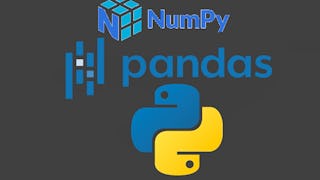This course delves into advanced data structures in Python, focusing on the powerful capabilities of the NumPy and Pandas libraries. It introduces the ndarray, a multidimensional array object provided by NumPy, enabling efficient storage and manipulation of large datasets. Additionally, learners will explore the Series and DataFrame structures offered by Pandas, which facilitate data analysis and manipulation in a more user-friendly manner. Throughout the course, students will engage in practical exercises and case studies to reinforce their understanding of how these advanced data structures can be applied in real-world scenarios.


您将学到什么
Understanding and utilizing the ndarray from the NumPy library.
Exploring the Series and DataFrame structures in the Pandas library.
Practical applications of advanced data structures in data analysis and manipulation.
您将获得的技能
要了解的详细信息

添加到您的领英档案
5 项作业
了解顶级公司的员工如何掌握热门技能

积累特定领域的专业知识
- 向行业专家学习新概念
- 获得对主题或工具的基础理解
- 通过实践项目培养工作相关技能
- 获得可共享的职业证书

该课程共有5个模块
This module introduces the ndarray, the core data structure of the NumPy library that allows for efficient manipulation of large, multi-dimensional arrays. It begins with an overview of what an ndarray is and compares its capabilities to Python's built-in list data structure. The module then covers how to create ndarray objects, access and manipulate both 1D and 2D arrays, and perform various operations on these arrays. By the end of this module, learners will gain a solid understanding of how to effectively use ndarray for numerical and data analysis tasks.
涵盖的内容
6篇阅读材料1个作业6个非评分实验室
This module delves deeper into the NumPy library, focusing on its powerful features and functionalities. It covers universal functions (ufuncs) that allow for element-wise operations on ndarray, enabling efficient computation across large datasets. The module also explores various statistical methods available in NumPy, linear algebra operations for solving mathematical problems, random number generation for simulations and modeling, and masking techniques for filtering data. By the end of this module, learners will be equipped with the skills to leverage NumPy's capabilities for advanced numerical analysis.
涵盖的内容
1篇阅读材料1个作业5个非评分实验室
This module introduces the Series data structure in Pandas, which is a one-dimensional labeled array capable of holding any data type. It begins by defining what a Series is and its significance in data analysis. The module covers various methods to create a Series, including using lists, dictionaries, and NumPy arrays. Learners will also explore how to access and manipulate elements within a Series, as well as perform mathematical operations on Series data. By the end of this module, students will understand how to utilize Series for effective data manipulation and analysis.
涵盖的内容
2篇阅读材料1个作业3个非评分实验室
This module introduces the DataFrame data structure in Pandas, which is a two-dimensional labeled data structure that can hold heterogeneous data types. The module begins by defining what a DataFrame is and its significance in data analysis and manipulation. Learners will explore various methods to create DataFrames from sources such as dictionaries, lists, and external files (e.g., CSV). The module covers how to access data within a DataFrame using labels and indices, manipulate rows and columns, and perform operations such as merging and concatenating multiple DataFrames. By the end of this module, students will be proficient in utilizing DataFrames for data manipulation tasks.
涵盖的内容
2篇阅读材料1个作业7个非评分实验室
This module provides an in-depth exploration of the Pandas library, which is essential for data manipulation and analysis in Python. It starts with an overview of what Pandas is and its significance in data science. The module highlights useful functionalities within Pandas, including data loading, cleaning, and preparation. Learners will examine how to generate descriptive statistics for both numerical and categorical columns, use the groupby() method for data aggregation, and handle missing and duplicate values effectively. By the end of this module, students will have a solid understanding of how to leverage Pandas for comprehensive data analysis.
涵盖的内容
2篇阅读材料1个作业6个非评分实验室
获得职业证书
将此证书添加到您的 LinkedIn 个人资料、简历或履历中。在社交媒体和绩效考核中分享。
位教师

从 Data Analysis 浏览更多内容

Coursera Project Network
 状态:免费试用
状态:免费试用University of Michigan
 状态:免费试用
状态:免费试用 状态:免费试用
状态:免费试用University of Colorado Boulder
人们为什么选择 Coursera 来帮助自己实现职业发展




常见问题
To access the course materials, assignments and to earn a Certificate, you will need to purchase the Certificate experience when you enroll in a course. You can try a Free Trial instead, or apply for Financial Aid. The course may offer 'Full Course, No Certificate' instead. This option lets you see all course materials, submit required assessments, and get a final grade. This also means that you will not be able to purchase a Certificate experience.
When you enroll in the course, you get access to all of the courses in the Specialization, and you earn a certificate when you complete the work. Your electronic Certificate will be added to your Accomplishments page - from there, you can print your Certificate or add it to your LinkedIn profile.
Yes. In select learning programs, you can apply for financial aid or a scholarship if you can’t afford the enrollment fee. If fin aid or scholarship is available for your learning program selection, you’ll find a link to apply on the description page.
更多问题
提供助学金,

 中
中

